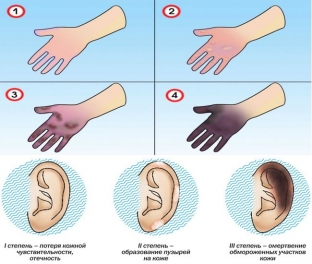It is not in vain that mothers and grandmothers in childhood make children wrap themselves in warm scarves, wear hats, knitted socks and mittens. Despite the fact that in the 21st century the availability of information through the Internet and television rolls over, the number of patients admitted to hospitals with a diagnosis of frostbite is not decreasing. Prolonged exposure to low temperatures on the human body does not pass without a trace. Parts of the body such as the nose, ears, fingers and toes are often subject to frostbite, and this can lead to their complete loss. Each person should have the necessary amount of information about the symptoms of frostbite and how this condition should be treated.
Symptoms and immediate measures for frostbite
Frostbite is a pathological syndrome that occurs when certain areas of the human body are exposed to low temperatures for a long time. With frostbite, circulatory disorders occur in the skin and deeper tissues of the body, as a result of which many processes are disrupted and the disease can become irreversible. The tactics of providing medical care depends on the stage of frostbite and the characteristic clinical manifestations of the disease. Timely and proper medical care will help the tissues of the body "warm up"; and return to normal operation.
Frostbite:
- two periods and four stages of frostbite: why it is important to know them;
- Clinical picture of frostbite depending on the degree of injury;
- Emergency measures for frostbite: how to help.
Two periods and four stages of frostbite: why it is important to know them
During frostbite, it is customary to distinguish two main periods and four stages, in each of which the main manifestation is pain. The pre-reactive period of frostbite begins from the moment of receiving a cold injury and continues until the start of warming of the affected area of the body. After warming, a reactive period of the pathological process develops, during which hypoxia, inflammation and necrosis of the affected areas can develop. The depth of tissue damage can be reliably determined not earlier than one or two days after receiving a cold injury.
There are 4 stages of frostbite:
- The beginning of the development of frostbite – at this stage, pain may be absent altogether or be insignificant.
- The onset of frostbite and all the time of exposure to low temperatures on the affected area – no pain.
- The time immediately after warming – there is a pronounced pain syndrome.
- The time during which demarcation processes are developing – the pain continues for the first days after the injury and then decreases.
Clinical picture of frostbite depending on the degree of injury
The clinical picture of frostbite depends on the degree of the pathological process and the depth of tissue damage. There are 4 degrees of frostbite:
- At the 1st degree of frostbite, there are stabbing or burning pains in the affected areas, aching joints, sometimes pronounced itching, a feeling of swelling and various disorders of innervation. Objectively, the swelling of the affected areas is determined, the skin color is dark blue, purple-red, less often marble.
- At the 2nd degree of frostbite, the pain becomes more intense, disappears after a while and reappears. Blisters with transparent contents appear on the skin of the affected areas. They have a pink bottom covered with a fibrinous coating.
- At the 3rd degree of frostbite, the pain becomes even more pronounced, the blisters open up with the development of necrosis of the skin and underlying layers of soft tissues.
- For frostbite of the 4th degree, the intensity of pain depends on the volume and depth of the lesion.

First-time measures for frostbite: how to help
Emergency care for frostbite consists in restoring normal tissue temperature, combating shock manifestations and tissue hypoxia. First of all, you need to remember that rubbing the affected area with snow and drinking alcohol during frostbite is strictly contraindicated! The patient must be brought into a warm room and undressed. The affected area is treated with alcohol or an antiseptic to prevent microorganisms from entering the wound and developing a bacterial process. Then the affected area is wiped dry and a heat-insulating bandage is applied to it, then the entire limb is covered with a warm cloth. If after warming the pain syndrome decreases – this indicates mild frostbite that does not require assistance in a hospital setting. If the pain syndrome does not go away, and the affected area remains pale and cold – frostbite is most likely stage 3-4 and the patient needs to be hospitalized.






Add a comment